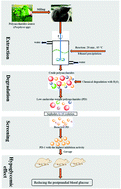A novel hypoglycemic agent: polysaccharides from laver (Porphyra spp.)†
Abstract
Type-II diabetes mellitus (T2DM) has become one of the most prevalent diseases on Earth and some treatments have been developed to manage it. One intestinal enzyme α-amylase can break down starch to glucose. Inhibiting its activity will control blood glucose and provide an essential approach for the management of T2DM. Alpha-amylase inhibitor (α-AI) specifically inhibits the activity of α-amylase, and reduces the blood glucose level efficiently. To develop a novel α-AI, the red seaweed laver (Porphyra spp.) was exploited in this work, whose extracts contain polysaccharides showing an inhibitory effect against α-amylase. The crude polysaccharides were extracted using hot water (85 °C) and degraded to low-molecular-weight polysaccharides with 7% of H2O2. One polysaccharide PD-1 exhibiting a competitive binding mode with an IC50 of 12.72 mg mL−1 was separated from these degraded polysaccharides, showing approximately 98.78% of α-amylase inhibition activity. In vivo, PD-1 could efficiently suppress postprandial blood glucose levels in normal and diabetic rats. The polysaccharide inhibitor from red seaweed laver could be regarded as a novel functional food ingredient in T2DM management.



 Please wait while we load your content...
Please wait while we load your content...